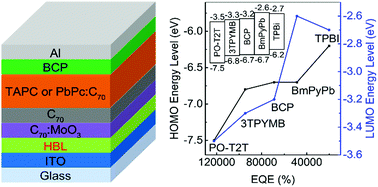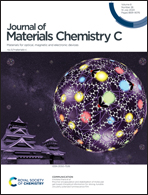Role of interfaces in controlling charge accumulation and injection in the photodetection performance of photomultiplication-type organic photodetectors†
Abstract
Large tunneling of electrons from the electrode by hole accumulation is an efficient way to realize photomultiplication-type organic photodetectors, in which the interface plays a very important role in the control of charge accumulation and injection. Here, we systematically studied the effects of the hole blocking layer (HBL) on the photodetection performance of the resulting photomultiplication-type organic photodetectors and found that the larger highest occupied molecular orbital (HOMO) and lowest unoccupied molecular orbital (LUMO) energy levels and higher electron mobility of the used HBL materials are more conducive to the hole accumulation and electron injection, thus achieving higher external quantum efficiency (EQE). However, as we see, this also brought about a large dark current. For this, we further introduced electron traps by doping MoO3 in the electron transporting layer near the HBL to reduce the electron injection at the dark state by the electron trapping effect of MoO3. Finally, the optimized photodetectors showed high EQEs of over 10 000% in the wavelength range of 300–650 nm and the maximum EQE was as high as 122 270% at 345 nm wavelength under −6 V reverse bias. The corresponding specific detectivity reached 5.9 × 1012 Jones.



 Please wait while we load your content...
Please wait while we load your content...